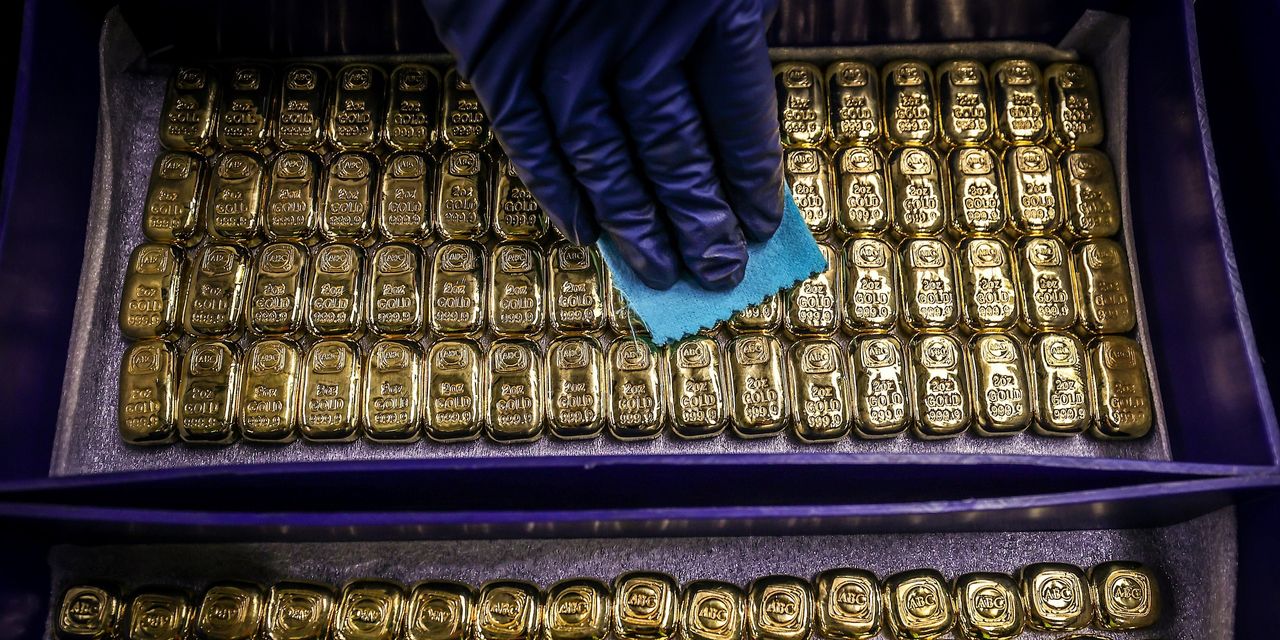Gold has reached its lowest settlement since March, moving further away from the record-high levels that were within reach just five months ago, with prices headed toward a so-called “death cross” that could lead to further declines for the precious metal.
“Gold’s kryptonite is surging Treasury yields and a stronger dollar,” Edward Moya, senior market analyst at OANDA, told MarketWatch.
“Wall Street is having a major reset on where flows are going and that is clearly not gold’s way,” he said. “Fixed income is all of sudden attractive and that killed the short-term outlook for gold.”
December gold futures
GC00,
GCZ23,
fell $18.90, or 1%, to settle at $1,847.20 an ounce on Comex Monday. That was the lowest most-active contract finish since March 9, according to Dow Jones Market Data. Prices lost 5.1% in September and 3.3% in the third quarter.
The last time gold traded at such a low was over six months ago, when the U.S. regional banking crisis triggered an influx of buyers, Alex Kuptsikevich, FxPro senior market analyst, said in market commentary Monday. “Then, as now, the pressure on gold came from rising U.S. government bond yields and a reassessment of expectations for higher long-term interest rates.”
The drop in gold prices followed a rise in early May to $2,055.70, the second-highest settlement on record, and the highest for a most-active contract since Aug. 6, 2020.
Gold prices now look to be closing in on reaching a “death cross” — a technical term that generally indicates a bearish trend, one that occurs when an investment’s short-term moving average falls below a longer-term moving average. The 50-day moving average for December gold was at $1,948.34, while the 200-day moving average was at $1,982.13 on Monday, FactSet data show.
The last time the gold market saw a death cross was in July 2022, and that led to four months of declining gold prices, then a very sharp rebound going into 2023, said Brien Lundin, editor of Gold Newsletter. So a death cross “could signal more softness in gold and postpone the fall rally that many were hoping for.”
Rising Treasury yields sparked gold’s price dive, he said. Yields have continued to surge not only because investors are finally starting to believe the Federal Reserve’s “determination to keep rates higher for longer, but also as the U.S. Treasury is being forced to issue massive amounts of new paper into a market where traditional buyers are reducing their purchases,” said Lundin.
In Monday dealings, the yield on the 10-year Treasury
BX:TMUBMUSD10Y
was at 4.674%, up from 4.572% on Friday, after the U.S. government averted a weekend shutdown.
Gold is in the “danger zone,” and it will plunge below the $1,800 level if the 10-year Treasury yield rallies above 5%, said OANDA’s Moya.
He expects gold to “have its moment in the sun when the peak in the [U.S.] dollar is in place.”
On Monday, the ICE U.S. Dollar index
DXY
was up 0.6% at 106.87, around the highest levels of the year so far. Strength in the dollar can make dollar-denominated gold more expensive for foreign buyers.
“A rally towards $2,000 seems unlikely right now” for gold, said Moya. However, “upside could eventually target the $1,925 region.”
Meanwhile, Lundin believes the gold-price decline has been “exacerbated by trend-following traders in gold futures piling on after forcing the price through support.”
While the price could go even lower under this selling pressure, gold is “extremely oversold at this point,” he said.
Interest rates this high are “unsustainable,” Lundin said.
Today’s global economy and financial markets were “built upon a foundation of zeroed interest rates, and you can’t follow that with the steepest and harshest hiking cycle in history without breaking something,” he said. “The chances of a market event forcing the Fed to pivot are actually higher now than ever before in this hiking cycle.”
“ “The chances of a market event forcing the Fed to pivot are actually higher now than ever before in this hiking cycle. That could come at any time, and that’s where a bet on gold at these oversold levels could pay off handsomely.” ”
A Fed pivot could “come at any time, and that’s where a bet on gold at these oversold levels could pay off handsomely,” said Lundin.
See: ‘Eventually something will break’: JPMorgan strategist warns rising bond yields could unleash a ‘financial accident’
Read the full article here











Leave a Reply